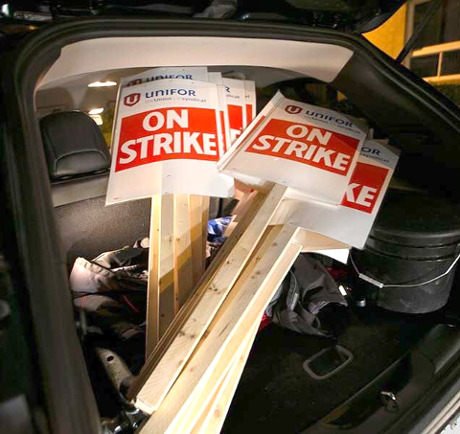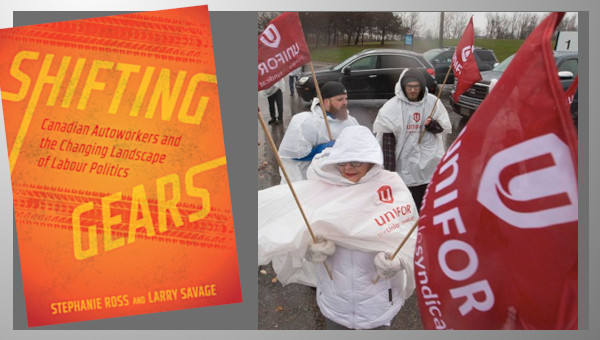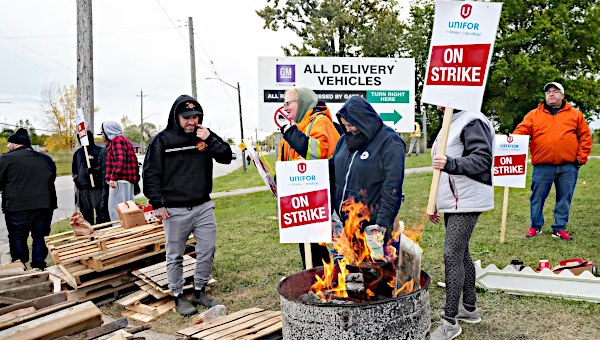As bargaining between Unifor and the Canadian branches of the Detroit Three automakers came down to the last company, Ford, the signs were pointing to an emerging resistance to decades of concessions. Amid general opposition on the shop floor, leaders at the biggest Ford local were openly opposing the pattern the union had bargained with General Motors and Fiat Chrysler (FCA).
 But at the October 31st deadline, the Unifor locals reached a tentative agreement with Ford, based on the pattern. Ratification votes were held November 5 and 6 and the agreement was narrowly passed by 58% across the Ford Canada local unions and therefore came into effect, even though it was rejected by 55% at Local 707 in Oakville.
But at the October 31st deadline, the Unifor locals reached a tentative agreement with Ford, based on the pattern. Ratification votes were held November 5 and 6 and the agreement was narrowly passed by 58% across the Ford Canada local unions and therefore came into effect, even though it was rejected by 55% at Local 707 in Oakville.
This year’s pattern offers weak raises, maintains the 10-year wage grow-in for recent and future hires, and eliminates the
defined-benefit pension for future hires. Workers ratified it in lackluster votes at GM September 25 and FCA October 16.
It was hoped that if Ford workers rejected the agreement, this could have become the spark for a wider opposition to the current direction of Unifor’s leadership.
Opposition had been building at the Ford Oakville plant – with 5,000 members, by far the largest of Unifor’s three Ford locals. The widespread feeling is that a continued two-tier is unfair, given the company’s enormous profits.
“The GM pattern won’t fly with the membership of Local 707,” said Local President Dave Thomas last week. But the leaders of the Oakville local endorsed the agreement bargained on Halloween.
Leading into the midnight bargaining deadline, Ford had agreed to resolve all local issues at Oakville and promised new investment in its Windsor facility (part of Local 200) – but threatened to pull all its production out of Canada if the union rejected the pattern.
So Long, Pension
Investment promises were part of the pattern at the other companies, too. GM promised to invest $554-million in its plants in St. Catharines and Oshawa and a parts depot in Woodstock. FCA promised $325-million to refurbish the paint shop in its Brampton plant, plus a new product in 2020.
But these promises came with conditions, and a cost. The GM investments were said to be “overflow” – that is, coming only if the demand for current products produced in the U.S. requires more production, rather than “new” products. Both companies’ promises were conditional on expected subsidies from the federal and provincial governments – essentially, bribes to buy potential new jobs.
The agreements only partially addressed the massive concessions the companies got in the wake of the 2008 bankruptcy emergency. As bargaining began this year, workers’ inflation-adjusted hourly pay was down 16 per cent from what it was in 2008. That’s because the base rate has been frozen all that time, and the annual cost-of-living allowance (COLA) suspended. New hires lost even more pay, and in 2012 had their defined-benefit pension reduced to a “hybrid” plan.
This year’s GM pattern provides increases of 4 per cent over a four-year contract, along with a series of signing bonuses and lump sums. The COLA remains suspended. There is no COLA for existing retirees, either.
And newly hired workers lost the defined-benefit portion of their hybrid pension. A defined benefit is the type of plan that guarantees a specific amount of pension income after retirement. These kinds of pensions are under attack; they still exist mainly in the public sector.
Instead the union bargained a defined-contribution plan for future hires. This is a risky scheme where the employer and worker both contribute to an individual investment instrument – a registered retirement savings plan (RRSP) in Canada, something like a 401(k) in the USA.
The move sends a message to other employers in Canada that decent pensions are fair game.
‘Grow-In’ Remains
The pattern does address an even lower tier – Supplemental Workforce Employees (SWE). All 700 SWEs in Oshawa, GM’s biggest Canadian plant, became full-time at ratification. But they will integrate into a 10-year grow-in that remains – despite wage increases, lump sums, and an end to a previous three-year freeze – essentially unchanged.
There was no effort to match the eight-year grow-in that the Auto Workers (UAW) were forced to accept, after Chrysler workers rejected the pattern the union tried to impose there. (The U.S. grow-in was a definite improvement over the permanent two-tier system it replaced, though the deal contained its own compromises.)
Unifor leaders touted “thousands of dollars” in raises, lump sums, and signing bonuses. But it was clear from the “highlights” passed
out at the ratification meetings that union leaders had no plan to challenge two-tier. The documents presented at GM and FCA included the following paragraph:
“The Unifor Master Bargaining Committee pursued with all three companies the idea of shortening the current 10-year wage progression understanding that Unifor members wanted to see improvements. In the eyes of U.S.-based CEOs, the 10-year progression was crucial for attracting new investment and new product in Canada (our number one priority in 2016 contract negotiations). On this point, the companies were unanimous and aggressive in rejecting any change to the progression length. It’s important to note that shortening the length of the progression is not the only way to make improvements. Therefore, to ensure the Committee met its investment objectives, attention turned to winning improvements to the progression so that members would receive higher and more consistent wage increases.”
Even with the pay increases factored in, a new hire will lose about $200,000 compared to what he or she would have made before the 2008 concession (when starting pay was set at 85 per cent of the top rate, with a three-month grow-in), or $90,000 compared to before the 2009 concession (70 per cent, six years).
Clearly the two-tier wage structure that former CAW President Bob White once called a “cancer” was not going to be eliminated or reduced in these agreements.
Defending the Indefensible
To defend the pattern, Unifor leaders are trotting out the same tired arguments that UAW leaders have historically used to justify concessions. Union materials deny that the grow-in has anything to do with two-tier. They argue it’s necessary for business success.
“If I’m working on the line, I’m going to make the same money regardless of which one of the Detroit Three (it is),” Unifor President Jerry Dias claimed in the Detroit News. But that ignores the embarrassing reality that workers next to each other, doing similar jobs on the same line, are not getting the same money.
“To those who claim that Unifor has endangered pensions for everyone, I say this: You don’t know what you are talking about,” Dias wrote in the Huffington Post. “Thanks to this deal, there are real jobs and a pension, where none existed before. With no jobs, there can be no pension of any kind.” In other words, you’re lucky to have a job.
Ironically, the Canadian Auto Workers formed in 1984 in reaction to these kinds of concessions. CAW merged with the Communications, Energy and Paperworkers in 2013 to form Unifor – with 310,000 members, the country’s largest private-sector union.
Reluctance and Resistance
At GM the contract passed by 65 per cent, the lowest since the CAW was founded. FCA approved by 70 per cent. Many workers were happy that some kind of investment was promised, that there were raises (although modest), and that full-time work was promised to SWEs. But others saw the agreements’ weaknesses.
“The danger set out by this agreement will be felt by our fellow workers at both Ford and Chrysler, as pattern bargaining brings forward similar arrangements for their workers,” wrote GM SWE Corey Weir at the labour website rankandfile.ca on the eve of the ratification vote. “Tomorrow, we must vote this down and take a stand against any tentative agreement that defies a fundamental core principle of unionism – equal pay for equal work. It’s time for us to draw that line in the sand, and hold it.”
In the lead-up to negotiations, a handful of GM workers in Oshawa and St. Catharines had organized to push their union to challenge the multi-tier system, producing leaflets and T-shirts.
Even after the contract passed, they have continued their outreach to co-workers on these issues. Several have been discussing how they would summarize their unsuccessful effort. They plan to continue meeting, possibly support Ford workers who oppose the pattern in Oakville, and organize within their local unions.
“The one thing I have learned through this last experience is to not tone it down when talking about workers’ rights,” said one of the organizers, Rebecca Keetch. “Leadership is not leadership when they take away the members’ chance to make informed decisions and they have no right to accept conditions that they would never work under themselves, for others.”
Local 1988 at CAMI, which is part of GM but not the Master Agreement, also produced a leaflet condemning the concessions. But they can’t challenge the pattern because they don’t bargain this year.
Anger Over 10-Year Tier
Before this last-minute endorsement, Oakville bargaining committee members had said they would not endorse the pattern, and would vote against it if it were presented to Ford members in its current form. They spelled out some key demands:
- reduce the grow-in to eight years
- improve retirees’ healthcare
- retain the hybrid pension for new hires
- resolve some outstanding local issues at 707
On the eve of Ford bargaining, the committee called a membership meeting. More than 600 workers attended, and voted unanimously to vote down the pattern if it was offered.
“Every new hire in this plant absolutely hates that we have to work 10 years to get to full wage, when the guy we work next to worked 18 months before getting full rate,” an unnamed junior Oakville worker told the Windsor Star.
“Anyone willing to vote in this contract is doing it for the pathetic chump change they are calling a signing bonus, which after being taxed, is hardly worth being excited for,” the same worker said. “I’m sorry, but I’d rather strike to see my wages increase and everyone be taken care of than some signing bonus that wouldn’t even pay my bills for a month.”
“It’s sad that somebody can put the same nut and bolt on as I do and get paid half the wages as I do,” said longtime Oakville worker Larry Wells. “That’s not right. There should be equal pay for equal work.”
And he believes it’s a tactical error for the union to get drawn into bargaining over where the company will build its products.
“There’s always a trade-off – you don’t get something without giving something up,” Wells said. “I really feel when you bargain for product, you are just bargaining for concessions. We have to get out of that boat.”
Ford workers frustrated with the continued two-tier grow-in and the loss of real pensions for new hires could still reject the deal, as Chrysler workers did last year in the U.S. That’s when things would get really interesting.
Close Ratification Numbers
The contract was ratified overall by 58% – a very low figure. Plus, the Oakville plant – the largest local union, actually rejected it, 55% to 45%. There was about a 70% voting rate there. The problem was the overwhelming ratification vote in Windsor – a 90% participation rate, where the ratification vote was 89% in favour. Clearly, the leadership told the Windsor workers that without a ‘yes’ vote, they would not get the new investment.
The low overall ratification numbers reflected deep differences within the membership and a large and critical component of opposition to the pattern. Even with the bargaining committee in Oakville endorsing the agreement, (including the local president and plant chair) the contract was still voted down. That is unprecedented. With some real leadership (from the bottom or the top), that vote could have carried the overall Ford membership.
The reasons given by a number of workers were mixed, in Oakville: some saw a ‘yes’ vote as an act of solidarity with Windsor workers (encouraged by the leadership); some were scared of the plant closing from lack of future work if they rejected it; some liked the gains in the agreement. On the other hand, there were many comments in the newspapers from workers who opposed two-tier and the new pension regime.
Future Directions
One can argue that this contract symbolizes the end of the era of the CAW’s refreshing and trailblazing leadership of the struggle against neoliberalism across the labour movement and in the workplace. The era that began with the challenge to concessions, bonuses, free trade and the effects of lean production is bookended with an agreement that tails behind the American UAW, takes the ‘lead’ in ditching defined benefit pensions, and locks-in the two-tier workforce.
But then the potential for a new chapter to begin is still there: the rejection of the agreement in Ford’s largest workplace and Unifor’s largest auto local; the nature of the arguments made by those who spoke and voted against it; the germs of organization developing in Oshawa – all point in the direction of possible, new life for a collective resistance to the current regime in auto. Learning about the legacy of resistance, struggle, internal battles inside the union and the role of socialists – going back to the 1930s – is a key component of building on the real frustration and anger of today’s young workers. •





